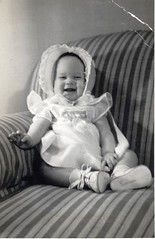This is the sister that took the photo of our old home in Wednesday's post. She's always been a popular person, and you can even see why in this picture.
I have been thinking a lot about material possessions. For me a great deal of memory and old narratives inheres in the things I have. This photograph, for instance, came to me when my mother's younger sister moved to much smaller living space. She dismantled her photo albums, and sent the photos to where she thought they would be most appreciated or usefui. This came with a small envelope mosly filled with pictures of me before I was five or six. (Susan was born when I was almost four.) The envelope represented a slice of time from about 1935-1941. Since the photos were all loose, they were easy to scan, and I scanned them almost at once. In this way, they went to the head of the line in the scanning projects that I hope to do, which includes a childhood album with many of the same pictures, or pictures taken at the same time as well as the whole era of my children from about 1956-1985 or so. Most of this is on slides and represents new equipment needed, planning and a significant investment of time. We won't deal here with whether there is any need (or demand) for these digital archives--this project is almost totally motivated by my wishing to work with the resulting images and making them into little narratives of their own, or perhaps having them to use in collages and other art work.
The crease in the upper right reminds me that this picture was sent from Scotia, New York to family in Mesa, Arizona. The copy in my baby book has been protected and has no crease, so the crease is part of the history. There is also a note on the back of the picture in my mother's striking and individual handwriting about Susan's progress. (She was a premature child and had already been hospitalized for scarlet fever.) I remember that when I was taken to see her in the hospital, we could look at her through a window, because she was in isolation. Associated with this is a memory of a small pink toy pig in a wire cradle. It was about 3 inches long and was made of some sort of plaster or chalky material with a shiny pink coating that peeled off. Later I used the pig like sidewalk chalk to draw hopscotch games on the sidewalk of First Street.. It wasn't suitable for an infant, so I must have gotten it about that time, even though I seem to remember it was hers and I wanted it--but I have tried many times to remember more than this, because the pig is so strongly connected in my memory with that visit to the window of the isolation ward. But this is all I have been able to recall.
The striped chair was slipcovered by my mother, the stripes were a dark coral on a cream ground. The sofa she did was done in the same pattern in brown stripes. These stripes appear in many photographs of this time, particularly at Christmas, which took place in the living room. Mother was proud of the workmanship in these slipcovers, which featured a beautiful even piping, inserted in the seams, and fitted the furniture without a wrinkle.
So, this one small photo reminds me of my own childhood, my sister's illness, my Aunt Louise, my mother's sewing skills and my baby sister. The slipcovers are gone, but if I had a piece of the fabric, that, too, would be precious to me.
Which brings me to a central question: in this time when people are being bombed out or driven from their homes, or cannot find work there to sustain themselves; when floods, tornado or fire takes away everything a family possesses in a few moments, how silly am I to remember, and treasure, the feel of a small pink chalk pig in my hand and the way he wore down--first his head, then his trunk--until only the tail end was left.
In the last couple of years, I notice more and more that bits and tags of language and song, or even just single, discrete words pop into my head for no reason. I can, and do, chase down the rest of the song or poem, or the definition or origin of a word through my beloved Google.
These bits and sounds--my father singing Annie Laurie--will vanish when I do, or even before. What we remember, why we remember, the uses of memory, the gathering and organization of family relics, these things interest me. I just bought The Stuff of Thought: Language as a Window into Human Nature by Steven Pinker, which I am hoping will deal with some of these issues. I haven’t started to read it yet. Good night.

I like this blog post. As I get older I realize that I don't need to shop for much but still like to look at merchandise and sometimes I succumb to buying something I really don't need.
ReplyDeleteMy husband has had two fires in his family: his mother's home and his one brother's home have burned to the ground. His mother lost some treasured items like a large handcrocheted table cloth, a Hale, Mo quilt that neighbors made together and signed in pen, Hummels my husband sent from Germany. But most of all we lost lots of photos that no one else had a copy of. I think when you lose important photos you do feel like you have lost your memory and hence your own idenity.It becomes an alzheimer's moment. Joann in Haymarket, VA. P.S. Keep posting. I love reading your thoughts on life.